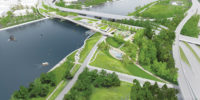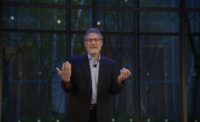In late November, the AIA held its first Build America Summit in New York, a conference that had special resonance in the wake of the presidential election. We are facing policy shifts in Washington that could well have a profound impact on the built environment. The topic of rebuilding America’s deteriorating infrastructure—and creating jobs—was a hot campaign issue, though neither President-elect Trump nor Hillary Clinton came close to proposing the amount that the American Society of Civil Engineers estimates is really needed, a sum north of $3.5 trillion by 2020. And the President-elect’s notion to finance infrastructure largely though mega tax breaks to private developers probably wouldn’t help parts of the public realm that require serious funding and really matter to people.
The reason? Infrastructure doesn’t just mean big-muscle projects like highways and airports. According to a public-opinion survey conducted by the Harris Poll and released at the AIA conference, 83 percent of the respondents said they considered schools, libraries, and parks part of their community infrastructure—and that those needed investment as much as roads or bridges. Such social infrastructure, and the basic role of local governments in building those projects, emerged as a key theme of the conference.
In addition, almost three-quarters of those polled in the survey believe that schools in good condition are essential to their communities. Yet new school construction has suffered from funding cuts in many parts of the country. K–12 schools account for about one-quarter of infrastructure expenditures on the state and local levels, but capital spending by states overall dropped 37 percent between 2008 and 2013, according to the Center on Budget and Policy Priorities. A recent report, from the 21st Century School Fund, the National Council on School Facilities, and the Center for Green Schools, estimates that, across the nation, there is a shortfall of $10 billion a year for funding new facilities. Studies have repeatedly shown that well-designed classrooms, with ample natural light and good ventilation, improve learning. But the schools that most need upgrading are those least likely to find the means to do so. Municipalities in poor areas, where the tax base has eroded, have struggled to pay for even basic teaching tools. Reform of school financing to create equity in public education is urgently needed in the states and districts that still rely on their localities’ property taxes to determine funding.
This is RECORD’s annual schools issue, and the innovative K–12 facilities you will see on the following pages, in both the U.S. and abroad, arguably serve the luckiest students. Whether they are public, charter, or private, these schools have in common a sensitive use of materials and daylighting, and they all find ways to connect to nature. A private high school designed by Lake|Flato in Birmingham, Alabama, overlooking a lake, could be a contemporary summer camp, with a cluster of structures that have deep overhangs and generous porches. On a vastly different scale and budget, the Lycée Schorge secondary school in Burkina Faso by Francis Kéré, reflects its context in its plan and materials, and how it provides shading and cooling. The Common Ground High School, a charter in New Haven, Connecticut, designed by Gray Organschi Architecture, has an environmental focus in its curriculum and in its building—a wood structure is one of its sustainable elements.
Later this month, the new administration will take office. Through Congressional hearings for appointees, we’ll get a strong sense of how the cabinet will push for policies that will have an impact on social infrastructure. The proposed Secretary of Education, Betsy DeVos, for example, is a staunch promoter of charter schools, and if federal funding heavily favors charters, poor public schools would be left with even fewer resources. The proposed head of the Environmental Protection Agency, Scott Pruitt, is a vigorous opponent of climate change regulations and, if confirmed, could undo some current rules that are making new and retrofitted federal buildings models of green construction.
Yet decisions about building schools will still reside with states and local districts. And some states and dozens of cities have been leaders in legislating remedies for climate change, as well championing social issues such as raising the minimum wage. So while change is inevitable in Washington, everyone who cares about good design and the public realm can act locally. This is the moment to push for improved social infrastructure in neighborhoods, towns, and cities. The not-so-radical idea that every child deserves a decent, well-designed school would be a good place to start.







Post a comment to this article
Report Abusive Comment